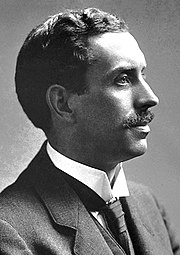Central for Research and Development for Winning
Nobel Prize in Physics at Indonesia
Nobel Fisika Indonesia
"for his discovery of the characteristic Röntgen radiation of the elements"
"Untuk penemuannya mengenai ciri-ciri radiasi Röntgen pada cuaca."
| Charles Barkla | |
|---|---|
 | |
| Born | Charles Glover Barkla 27 June 1877 Widnes, Lancashire, England |
| Died | 23 October 1944 (aged 67) Edinburgh, Scotland |
| Nationality | United Kingdom |
| Fields | Physics |
| Institutions | Cambridge University Liverpool University King's College London University of Edinburgh |
| Alma mater | University College Liverpool Cambridge University |
| Doctoral advisor | J. J. Thomson Oliver Lodge |
| Known for | X-ray scattering X-ray spectroscopy |
| Notable awards | Nobel Prize in Physics (1917) Hughes Medal of the Royal Society |
Charles Glover Barkla (lahir 7 Juni 1877 – meninggal 23 Oktober 1944 pada umur 67 tahun) adalah fisikawan Britania Raya.
Dilahirkan di Widnes dan belajar di Liverpool Institute dan Liverpool University. Pada 1913, setelah bekerja di perguruan-perguruan tinggi yang ada di Cambridge, Liverpool dan King's College Londonia diangkat sebagai guru besar filsafat alam di Universitas Edinburgh, kedudukan yang dipegangnya sampai meninggal.
Ia memperbaiki hukum penyebaran sinar-X dan hukum yang berpengaruh atas pengiriman sinar X melalui bahan dan eksitasi sinar-sinar sekunder. Untuk penemuannya pada sifat-sifat sinar-X ia menerima Penghargaan Nobel dalam Fisika 1917. Ia dianugerahi Hughes Medal dari Royal Society di tahun yang sama.
Biography
Barkla was born in Widnes, England, and he studied at the Liverpool Institute and atLiverpool University. In 1899, Barkla went to Trinity College, Cambridge, as an Exhibition Scholar to work in the Cavendish Laboratory under the physicist J. J. Thomson. At the end of a year and a half, his love of music led him to move on to King's College, Cambridge, where he joined its chapel choir. He completed his bachelor of arts degree in 1903, and then his Master of Arts degree in 1907.[1] No information seems to be available about when or where he earned a Doctor of Philosophy (Ph.D.) degree, but it is known that the great physicists J.J. Thompson (the discoverer of the electron) and Oliver Lodge were his doctoral advisors.
In 1913, after having worked at the Universities of Cambridge and Liverpool, and King's College, London, Barkla was appointed as a professor of natural philosophy at theUniversity of Edinburgh, a position that he held until his death. Barkla married Mary Esther Cowell in 1907.
Barkla made significant progress in developing and refining the laws of X-ray scattering,X-ray spectroscopy, the principles governing the transmission of X-rays through matter, and especially the principles of the excitation of secondary X-rays. For his discovery of the characteristic X-rays of elements, Barkla was awarded the Nobel Prize in Physics in 1917. He was also awarded the Hughes Medal of the British Royal Society that same year.
Little more seems to have been recorded about the life of Charles Barkla.
CH A R L E S G . BA R K L A
Characteristic Röntgen radiation
Nobel Lecture, ]une 3, 1920
I have had some difficulty in deciding what to speak about to-day. Much of my work on characteristic radiation is already comparatively old and may be familiar to many of you, as it has been summarized in such works as the ahrbuch der Radioaktivität und Elektronik and Professor Stark’s Atomdynamik.
I shall therefore choose two, and only two, points which are of more recent interest - firstly, the results of my own experiments which have a bearing on the Quantum Theory of Radiation; secondly, the evidence for another series of characteristic radiations - a J series*.
The quantum theory of radiation
Phenomena of scattering - The results of experiments on the scattering of Xrays, which have an obvious bearing on the Quantum Theory of Radiation, may be briefly summarized. When X-rays traverse matter of any kind, this matter becomes a source of a radiation similar in character to that of the primary radiation falling upon it. A variation in the intensity of this scattered radiation with direction around the primary beam shows slight polarization of the primary radiation proceeding direct from an X-ray tube.
The scattered radiation proceeding in a direction at right angles to that of propagation of the primary radiation is highly polarized in the manner of light scattered from the sky.
The Nobel Prize in Physics 1917
Sumber:
1. Wikipedia
2. Nobel Prize Org.
Ucapan Terima Kasih:
Ucapan Terima Kasih:
1. DEPDIKNAS Republik Indonesia
2. Kementrian Riset dan Teknologi Indonesia
3. Lembaga Ilmu Pengetahuan Indonesia (LIPI)
4. Akademi Ilmu Pengetahuan Indonesia
5. Tim Olimpiade Fisika Indonesia
Disusun Ulang Oleh:
Arip Nurahman
Pendidikan Fisika, FPMIPA, Universitas Pendidikan Indonesia
&
Follower Open Course Ware at MIT-Harvard University, USA.
Semoga Bermanfaat dan Terima Kasih























